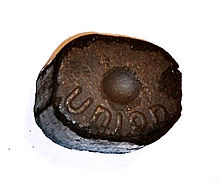Lignite



Lignite, often referred to as brown coal, or Rosebud coal by Northern Pacific Railroad, is a soft brown fuel with characteristics that put it somewhere between coal and peat. It is considered the lowest rank of coal; it is mined in Greece, Germany, Poland, Serbia, Russia, the United States, India, Australia and many other parts of Europe and it is used almost exclusively as a fuel for steam-electric power generation. Up to 50% of Greece's electricity and 24.6%[1] of Germany's comes from lignite power plants.
Characteristics
Lignite is brownish-black in color and has a carbon content of around 25-35%, a high inherent moisture content sometimes as high as 66%, and an ash content ranging from 6% to 19% compared with 6% to 12% for bituminous coal.[2]
The energy content of lignite ranges from 10 - 20 MJ/kg (9–17 million BTU per short ton) on a moist, mineral-matter-free basis. The energy content of lignite consumed in the United States averages 15 MJ/kg (13 million BTU/ton), on the as-received basis (i.e., containing both inherent moisture and mineral matter). The energy content of lignite consumed in Victoria, Australia averages 8.4 MJ/kg (6.5 million BTU/ton). When reacted with quaternary amine, amine treated lignite (ATL) forms. ATL is used in drilling mud to reduce fluid loss.
Lignite has a high content of volatile matter which makes it easier to convert into gas and liquid petroleum products than higher ranking coals. However, its high moisture content and susceptibility to spontaneous combustion can cause problems in transportation and storage. However, it is now known that efficient processes that remove latent moisture locked within the structure of brown coal will relegate the risk of spontaneous combustion to the same level as black coal, will transform the calorific value of brown coal to a black coal equivalent fuel while significantly reducing the emissions profile of 'densified' brown coal to a level similar to or better than most black coals.[3]
Uses
Because of its low energy density and typically high moisture content, brown coal is inefficient to transport and is not traded extensively on the world market compared with higher coal grades. It is often burned in power stations constructed very close to any mines, such as in Australia's Latrobe Valley and Luminant's Monticello plant in Texas. Primarily because of latent high moisture content of brown coal, carbon dioxide emissions from traditional brown-coal-fired plants are generally much higher than for comparable black-coal plants, with the world's highest-emitting being Hazelwood Power Station, Victoria.[4] The operation of traditional brown-coal plants, particularly in combination with strip mining, can be politically contentious due to environmental concerns.[5][6]
Geology
Lignite is geologically younger than higher-grade coals, originating mainly in the Tertiary period.
The Latrobe Valley in the state of Victoria, Australia contains estimated reserves of some 200,000 million tonnes (Mt) of brown coal. The deposit is equivalent to 25% of known world reserves. The coal seams are generally of considerable thickness (to 300 metres) and are covered by very little overburden (2 to 5 metres).[7]
Types
Lignite can be separated into two types. The first is xyloid lignite or fossil wood and the second form is the compact lignite or perfect lignite.
Although xyloid lignite may sometimes have the tenacity and the appearance of ordinary wood it can be seen that the combustible woody tissue has experienced a great modification. It is reducible to a fine powder by trituration and if submitted to the action of a weak solution of potash it yields a considerable quantity of ulmic acid.[8]
Production
| Country | 1970 | 1980 | 1990 | 2000 | 2001 | 2011 |
|---|---|---|---|---|---|---|
| 369.3 | 388.0 | 356.5 | 167.7 | 175.4 | ||
| 127.0 | 141.0 | 137.3 | 86.4 | 83.2 | ||
| 5.4 | 42.3 | 82.6 | 83.5 | 80.5 | ||
| 24.2 | 32.9 | 46.0 | 65.0 | 67.8 | ||
| 8.1 | 23.2 | 51.7 | 63.3 | 67.0 | ||
| 32.8 | 36.9 | 67.6 | 61.3 | 59.5 | ||
| 4.4 | 15.0 | 43.8 | 63.0 | 57.2 | ||
| 67.0 | 87.0 | 71.0 | 50.1 | 50.7 | ||
| 13.0 | 22.0 | 38.0 | 40.0 | 47.0 | ||
| 26.0 | 43.0 | 60.0 | - | - | ||
| - | - | - | 35.5 | 35.5 | ||
| 14.1 | 27.1 | 33.5 | 17.9 | 29.8 | ||
| 5.7 | 10.0 | 10.0 | 26.0 | 26.5 | ||
| Total | 804.0 | 1,028.0 | 1,214.0 | 877.4 | 894.8 |
See also
- Bergius process
- Coal assay
- Energy value of coal
- Orders of magnitude (specific energy density)
- Fischer-Tropsch process
- Karrick process
- Leonardite
- List of CO2 emitted per million Joule of energy from various fuels
References
- ^ "Nuclear power? Um, maybe". The Economist. 2010-09-02. Retrieved 2010-09-05.
- ^ Ghassemi, Abbas (2001). Handbook of Pollution Control and Waste Minimization. CRC Press. p. 434. ISBN 0-8247-0581-5.
{{cite book}}: Cite has empty unknown parameter:|coauthors=(help) - ^ George, A.M.. State Electricity Victoria, Petrographic Report No 17. 1975; Perry, G.J and Allardice, D.J. Coal Resources Conference, NZ 1987 Proc.1, Sec. 4.. Paper R4.1
- ^ "Hazelwood tops international list of dirty power stations". World Wide Fund for Nature Australia. Retrieved 2008-10-02.
- ^ "The Greens Won't Line Up For Dirty Brown Coal In The Valley". Australian Greens Victoria. 2006-08-18. Retrieved 2007-06-28.
- ^ "Greenpeace Germany Protests Brown Coal Power Stations". Environment News Service. 2004-05-28. Archived from the original on 2007-09-30. Retrieved 2007-06-28.
- ^ Australian Mines Atlas
- ^ Mackie, Samuel Joseph (1861). The Geologist. Original from Harvard University: Reynolds. pp. 197–200.

